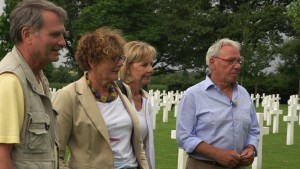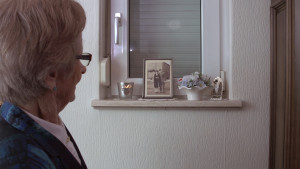Synopsis
Our Soldier presents two stories that illustrate how anonymous American soldiers are given a face by the war grave adoption program in the Netherlands.
Figuring in one of the stories are the filmmaker’s parents, Hub and Nel Bessems, who, like many others in their village, adopted an American soldier’s grave. In the film, Jotja Bessems follows her mother and father from the moment they are contacted by “our soldier’s” relatives in the USA.
In the other story, we recall the birth of the grave adoption program in 1945 with 83-year old Gerda Roebroeks-Nelissen. She describes the commitment her generation has always felt to preserve the memory of those who died on the battlefield, and how she instills this feeling in younger people. In an unexpected meeting between past and present, this film explores the present-day meaning of the price these soldiers paid for our freedom.
Meeting


It is the summer of 2013 when Betty Gene Birdwell Beck from Atlanta, Georgia is traveling through Europe and for the first time pays her respects to her uncle Sidney Stuart Beck at the Netherlands American Cemetery in Margraten. She discovers to her surprise that his grave has been adopted and decides she would like to meet the adopters, Hub and Nel Bessems. Their meeting is the point of departure for a quiet, touching, and occasionally funny portrait of 70 years of war grave adoptions and emotional ties.

A meeting like Jotja’s parents experienced is what Gerda Roebroeks-Nelissen has dreamed of for 70 years. This elderly lady adopted the grave of Henry W. Wolff. Like many people from the Zuid-Limburg region of the Netherlands, Gerda got to know her liberators personally and never forgot the sacrifices these young men made. She was 13 when Henry was quartered at her family home in Moerslag, a hamlet near Margraten. During the day, he manned the guns that were aimed in the direction of Germany. When Henry got his marching orders, Gerda’s family saw him off with fear in their hearts as he left for the Battle of the Bulge. Devastated by the news of his death, Gerda’s parents adopted his grave immediately after the war. To this very day, Gerda regularly visits his final resting place.
Adoption waiting list
In 1945, people from Margraten and its surroundings adopted the nearly 20,000 graves in the American military cemetery in this Dutch municipality in Zuid-Limburg. The villagers regularly left fresh flowers on “their soldier’s” graves and corresponded with the next of kin. Today, the thousands of white crosses in the Netherlands American Cemetery in Margraten look like an anonymous homage to the many allied soldiers who gave Europeans their freedom back. But as this film shows us, behind every grave there is a life. And there is a family that still lives with the memory of the son, nephew, uncle or father they lost. The adoptions help to keep that memory alive.

In 2015, the phenomenon of adoptions at the Margraten cemetery is alive and well. There are adopters from across the Netherlands, Germany and Belgium. Since 2008, there has been a waiting list for those who want to adopt the 8,301 graves still available.
Every year, the question arises in the Netherlands and Europe: How long do we want to keep on commemorating our liberation, a ceremony which has become nearly as anonymous as the fields of white crosses? But the unique adoption initiative in Margraten proves that there is still a human need to commemorate. Our Soldier shows us the meaning of this need.
The film: two adoption stories
Our Soldier reconstructs the adoption of two soldiers, their histories and families, from the perspective of the adopters.
Sidney
After their meeting at Sidney’s grave, we follow both the American family and the Dutch adopters. Betty Gene asks her sister to go through old family memorabilia with her, and she gathers her nephews and nieces to talk about Sidney. She also visits the family grave in Sidney’s birthplace of Valdosta, Georgia. We follow my parents as they lay flowers on the grave ahead of their first meeting with Betty Gene: at a point when, to us, Sidney Stuart Beck is still no more than a name on a white cross. The sketchy outline of his life is colored in with personal details as we hear the letters he wrote to his family back home while in Europe. We visit his grave with the entire family and symbolically reunite this young man who died on the battlefield with his family.

Henry
In Henry Wolff’s story, we see how the practice of adopting graves stemmed directly from the war itself and has remained an honored tradition ever since. Gerda is one of the few remaining people who are still alive to recall the entire story. With her vivid memory and endearing storytelling style she recollects the arrival of the American soldiers in Zuid-Limburg, the hilarious moments of confusion caused by the language barrier, the uncertainty surrounding the reburials after the war and the confusion she experienced when her frequent correspondence with Henry’s widow suddenly ends in silence. Now, 70 years later, she still lights a candle next to Henry’s portrait every day. She visits the house where she grew up, where soldiers were quartered during the war. We follow her as she attends the annual Memorial Day commemoration in Margraten, and see how she passes down the traditions of adoption to her children and grandchildren.

These two stories are told through personal letters, photos from the family archives, images rich with atmosphere and interviews on location in the USA and in Zuid-Limburg, illustrated with extraordinary archival material.
By combining the two narratives, Our Soldier draws parallels between the past and present. Gerda’s story begins in the past and makes its way to the present day, developing from personal involvement into a general gratitude that applies to all who died for her freedom. The story of the filmmaker’s family, by contrast, begins in the present day with the paying of respects to a soldier about whom they know nothing, other than his name. But this story line delves more and more deeply into the past, becoming an ever more personal narrative. The stories of Sidney and Henry reveal how a variety of individuals experience and pass on to younger generations the fascinating practice of adopting graves.
Theme
 Our Soldier is about the enormous impact of the loss of a loved one – an impact that even leaves its traces on people generations later. It is not a historical documentary, but a universal story about what war really means in the lives of ordinary people. Stripped of all the heroism, all the historical and political interests at stake, this is the true face of war: a girl sees her beloved uncle depart to a far away country to fight. Her uncle pens letters to her from the front lines, in which he makes up stories for her (how cool it must have been to receive those letters!). But then he is killed and she never sees him again. What does this mean for her and the entire family that remains behind? What impact does this have on the generations that follow?
Our Soldier is about the enormous impact of the loss of a loved one – an impact that even leaves its traces on people generations later. It is not a historical documentary, but a universal story about what war really means in the lives of ordinary people. Stripped of all the heroism, all the historical and political interests at stake, this is the true face of war: a girl sees her beloved uncle depart to a far away country to fight. Her uncle pens letters to her from the front lines, in which he makes up stories for her (how cool it must have been to receive those letters!). But then he is killed and she never sees him again. What does this mean for her and the entire family that remains behind? What impact does this have on the generations that follow?